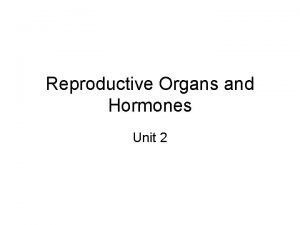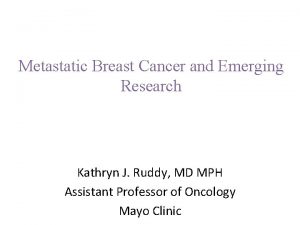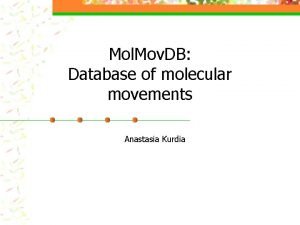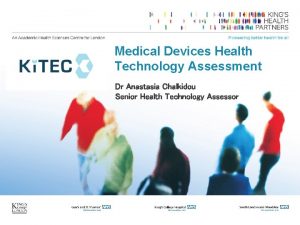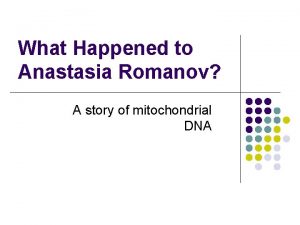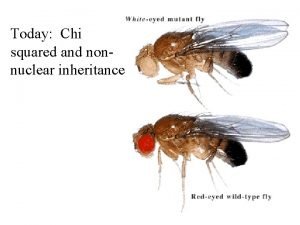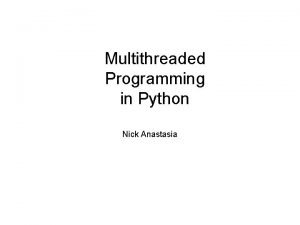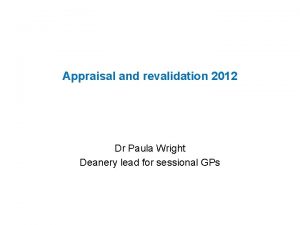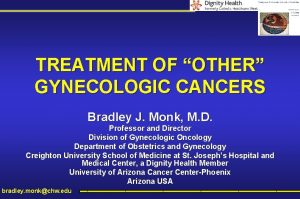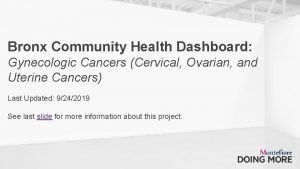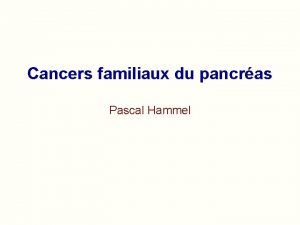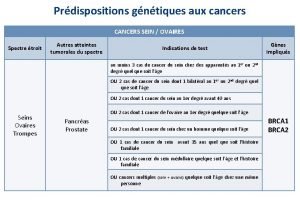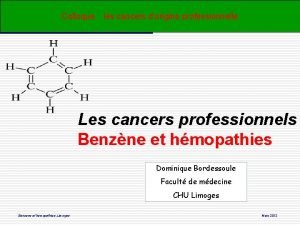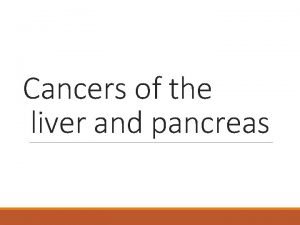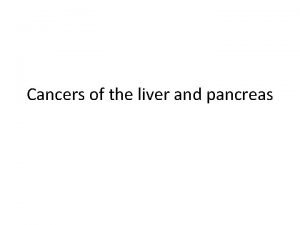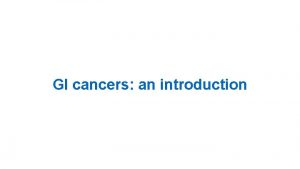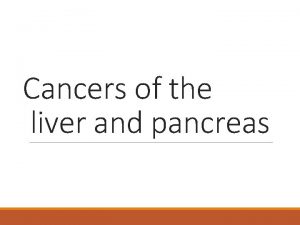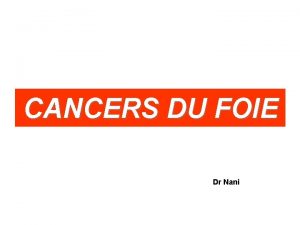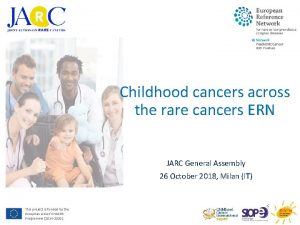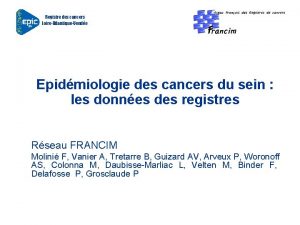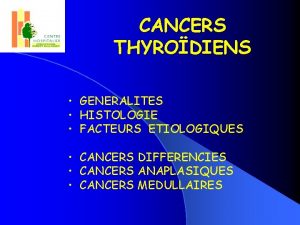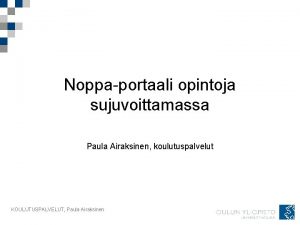Module 12 Gynecologic Cancers Paula J Anastasia RN




















































- Slides: 52

Module 12: Gynecologic Cancers Paula J Anastasia, RN, MN, AOCN Kathleen Moore, MD

Approximately how many patients with the following types of cancer have you interacted with over the past year? Type of cancer Median Breast cancer 40 Ovarian cancer 6 Lung cancer 35 Renal cell carcinoma 6 Colorectal cancer 30 Hepatocellular carcinoma 5 Myelodysplastic syndromes 20 Gastric cancer 5 Multiple myeloma 20 Chronic lymphocytic leukemia 15 Acute myeloid leukemia 4 Pancreatic cancer 10 Hodgkin lymphoma 4 Diffuse large B-cell lymphoma 10 Urothelial bladder cancer 4 Prostate cancer 10 Endometrial cancer 3 Follicular lymphoma 7 Cervical cancer 2 Melanoma 6 Mantle cell lymphoma 2

Day in the Life: Ovarian (Cervical/Endometrial Cancer) • 44 F, niraparib, 3 small children • 59 F, carboplatin/paclitaxel, humility • 32 F, nab paclitaxel, has the best caregiving husband • 56 F, pembrolizumab after multiple prior lines of therapy, rheumatoid arthritis pain but can't increase prednisone due to pembrolizumab • 69 F, carboplatin/paclitaxel, refractory insomnia • 64 F, nab paclitaxel, significant neuropathy but insisted on continuing chemo • 48 F, bevacizumab and topotecan, developed uncontrolled HTN resulting in us holding her bevacizumab for the last few weeks • 66 F, olaparib, fighting this for years, fired by her gyn/onc

Day in the Life: Ovarian (Cervical/Endometrial Cancer) • 47 F, paclitaxel/carboplatin, under the Cool. Cap for 7 hours each treatment! Quite a trooper! • 70 F, rucaparib, asks repeated questions • 72 F, niraparib, big hugger and open to listening • 65 F, EC, carboplatin/paclitaxel, grateful • 79 F, EC, carboplatin/paclitaxel, always bakes sweets for the staff • 74 F, EC, lung and bone mets, bevacizumab, informative • 27 F, cervical cancer, cisplatin, fierce • 63 F, cervical cancer and HCC, cisplatin, liver, lung and bone mets

Ovarian Cancer

Patients with ovarian cancer should generally have the following assay done at diagnosis regardless of family history of cancer. a. BRCA germline testing b. BRCA somatic testing c. Multiplex germline testing d. Multiplex somatic testing e. Both a and b f. Both c and d g. I don’t know

Which of the following maintenance therapies has been demonstrated to reduce the risk of disease relapse or progression for patients who have undergone debulking surgery followed by chemotherapy for Stage III ovarian cancer with a BRCA germline mutation? a. Olaparib b. Niraparib c. Rucaparib d. All of the above e. Only a and b f. Only b and c g. Only a and c h. I don’t know

Which of the following maintenance therapies has been demonstrated to reduce the risk of disease relapse or progression for patients who have undergone debulking surgery followed by chemotherapy for Stage III ovarian cancer without a BRCA germline mutation? a. Olaparib b. Niraparib c. Rucaparib d. All of the above e. Only a and b f. Only b and c g. Only a and c h. I don’t know

Case 1: Olaparib Maintenance • 60 yr G 2 P 0 Caucasian, non-Jewish g. BRCA 1 mutation (multi panel genetic testing after diagnosis) • Her brother tested negative. Her parents are deceased • Stage 3 C High Grade Serous OVCA – optimal debulk 8/3/18 • 6 cycles IV paclitaxel/carbo 09/2018 -1/2019. Used Cold Caps • CA 125 pre-surgery: 2762, post op 89, after cycle 6, CA 125 = 7 • Post chemo CT chest, abd, pelvis: NED • Started Olaparib Maintenance 300 mg po BID 2/2019 • Plan: Weekly CBC x 4, Monthly CMPL and CA-125 then q 3 mo

Last Chemo Christmas Eve (wearing cold cap) Christmas morning with her dog Sophie New Years Eve out dancing with her husband

Case 1: Social Hx • Married x 35 yrs, supportive husband, they enjoy traveling • They have a 6 yr old dog • She has large circle of girlfriends • Works full time CEO investment company, flexible hours • Lives out of state, and vacation home in Southern California • She received chemotherapy in California, drove 2 -3 hrs one way for chemotherapy appts in LA • Equestrian Horse Rider

Case 1: Adverse Events • CBC x 4 weeks • Day 17: WBC: 2. 5 ANC: 1000 Hgb: 9. 1 Plt: 123 K • Grade 1 fatigue, no SOB, needing to rest prn • Held Olaparib x 1 week, repeat CBC: WBC 3. 5, ANC 1. 5, Hgb 9. 3, Plts 156 K • Dose Reduction from 300 mg BID (600 mg total dose) to 150 mg q am and 300 mg q hs (450 mg total dose) • Weekly CBC x 4 weeks • Stable: WBC 3 -4 K, Hgb 10+, Plts: 150+ • Now monthly CBC, CMPL and follow up calls monthly (or prn) exams q 3 months with CA 125 • Stable blood counts, maintaining all ADLS, grade 1 fatigue not interfering with ADLS • One year after her surgery, she placed 3 rd in national competition

Alaskan Cruise two weeks after starting Olaparib One year after her surgical debulking she won 3 rd place Nationally 10/2019 Patient is following up every 3 months with exam and CA 125; CBC, CMPL now every 2 months unless any new symptoms. Plan CT 1 year post Olaparib

A woman who weighs 140 pounds and has a platelet count of 200, 000 is about to begin niraparib. What is the optimal starting dose? a. 300 mg daily b. 200 mg daily c. 100 mg daily d. I don’t know

Case 2 • 51 G 4 P 4 Non Jewish female with Stage 3 C Grade 3 HGS ovarian cancer. g. BRCA negative. s/p Optimal Tumor Debulking. 6 cycles Paclitaxel/Carboplatin. CA -125 normalized after cycle 3 No growth factor or blood transfusions required • CT after cycle 6 = NED. Surveillance every 3 months • 12. 3 months DFI then rising CA 125 and CT with several retroperitoneal adenopathy • Carboplatin/gemcitabine/bevacizumab x 6. CA 125 normalized after 3 cycles • Grade 2 HTN: 136/92 requiring low dose amlodipine; stabilized • Molecular profile HRD+

Recurrent OVCA and Maintenance Therapy • Complete response after 6 cycles evidenced by NED on CT and normalization of CA 125 after cycle 2 • Growth factor support required w/ cycle 4 -6. No blood transfusion. Hgb nadir 9. 1. Plat nadir 137 K • Discussed Maintenance therapy with PARP Inhibitor given positive HRD (as opposed to Bevacizumab maintenance) • Started Niraparib 300 mg po daily. Weekly CBC • Day 23: WBC 3. 4, ANC 2. 9, Hgb 9. 1 Plats 75 K Grade 1 fatigue • Niraparib held for one week, Repeat CBC

Social History: Loves to celebrate family, cooking, and Disneyland. Milestones this year: one daughter’s college graduation, another daughter’s 20 th birthday. Her siblings visited from overseas

Case 2: Maintenance Therapy • CBC: WBC 3. 8, ANC 3. 0, Hgb 9. 3 Plats 172 K • Restarted Niraparib at 200 mg po daily • Weekly CBC x 4 weeks, CMPL monthly & CA 125 monthly x 3 months • Stable CBC, grade 1 fatigue and nausea not interfering with ADLS • Endorses insomnia evidenced as not being able to ‘sleep/nap’ in afternoon. She sleeps 6 -8 hrs at night. No sleep aids • BP remained stable on double dose amlodipine

Case 2: More Family and Cultural Celebrations. Enjoying snowball fights in Lake Arrowhead, California Patient remains NED 10 months on Maintenance Niraparib 200 mg PO

Paradigm Changes in the Treatment of Gynecologic Cancers Kathleen Moore, MD Virginia Kerley Cade Chair in Developmental Therapeutics Associate Director, Clinical Research Director, Early Phase Drug Development Stephenson Cancer Center, Oklahoma City

The Typical Course of Advanced Ovarian Cancer Surgery (primary or IDS) + primary or adjuvant chemotherapy +/- bevacizumab First-Line Treatment Stage III, IV First Response* Patients for whom platinum is an option, formerly ‘Platinum-Sensitive’ Follow-up Progression >6 months after completion of platinum-based chemotherapy Relapse/ Progression (70%– 80%) Second Response/ Disease Stabilisation Relapse/ Progression (100%) Patients for whom platinum is not an option, formerly ‘Platinum-Resistant’ Progression <6 months after completion of platinum-based chemotherapy *Around 5% of patients are primary treatment-refractory, meaning disease progressed during therapy or within 4 weeks after the last dose. IDS=interval debulking surgery. 1. Ledermann JA et al. Ann Oncol. 2013; 24(Suppl 6): vi 24 -vi 32. 2. Giornelli GH. Springerplus. 2016; 5(1): 1197. 3. Pignata S et al. Ann Oncol. 2017; 28(suppl_8): viii 51 -viii 56. 4. du Bois A et al. Cancer. 2009; 115(6): 1234 -1244. 5. Wilson MK et al. Ann Oncol. 2017; 28(4): 727 -732.

Progression-Free Survival (proportion) First-Line Chemotherapy Standard of Care (BRCAwt) Carboplatin and Paclitaxel ICON 8 Progression-Free Survival 1. 00 Standard (n=522) Weekly paclitaxel (n=523) Weekly carbo-paclitaxel (n=521) Progressions 330 (63%) 335 (64%) 338 (65%) Median PFS, mo 17. 9 20. 6 21. 1 Log rank (vs standard) P=0. 45 P=0. 56 HR vs Standard (97. 5% CI) 0. 92 (0. 77– 1. 09) 0. 94 (0. 79– 1. 12) 24. 9 months 25. 3 months Standard 0. 75 Weekly paclitaxel Weekly carbo-paclitaxel 0. 50 0. 25 0. 00 No. at risk Standard Weekly paclitaxel Weekly carbo-paclitaxel 0 6 12 18 24 30 36 42 48 Time from Randomisation (months) 54 60 66 522 523 521 471 489 468 354 383 385 250 279 281 18 17 15 3 3 6 1 0 0 198 210 208 130 144 153 92 92 99 59 59 66 32 28 33 Restricted means 24. 4 months Weekly dose-dense chemotherapy can be delivered successfully as first-line epithelial ovarian cancer treatment without substantial toxicity increase; it does not significantly improve PFS compared to standard 3 -weekly chemotherapy CI=confidence interval; HR=hazard ratio; PFS=progression-free survival. Clamp AR et al. Presented at: ESMO Annual Meeting; 2017.

Paradigm Shift 1: First-Line Chemotherapy Standard of Care (BRCAwt) Carboplatin, Paclitaxel & Bevacizumab + Maintenance ICON 72 GOG-02181 Paclitaxel + carboplatin + placebo Progression-Free Survival (proportion) No. at risk Chemotherapy Bev initiation Bev throughout Bevacizumab (Bev throughout) 14. 1 months HR (Bev throughout vs chemo) = 0. 717 10. 3 months 625 623 2 4 6 8 10 12 14 16 18 20 22 24 26 28 30 32 34 36 Time from Randomisation (months) 199 219 254 Paclitaxel + carboplatin + bevacizumab Bevacizumab Cycles 1– 6 Until disease progression or 12 cycles Until disease progression or up to 22 cycles Chemotherapy Bev initiation Bev throughout 0 Paclitaxel + carboplatin Advanced epithelial ovarian cancer Placebo (Bev Initiation) Paclitaxel + carboplatin + bevacizumab Cycles 1– 6; + bevacizumab at cycle 2 1. 0 0. 9 0. 8 0. 7 0. 6 0. 5 0. 4 0. 3 0. 2 0. 1 0. 0 Placebo 33 29 38 8 6 8 Bev=bevacizumab. 1. Burger RA et al. N Engl J Med. 2011; 365(26): 2473 -2483. 2. Perren TJ et al. N Engl J Med. 2011; 365(26): 2484 -2496. Progression-Free Survival (%) Advanced epithelial ovarian cancer 100 Chemotherapy Bevacizumab 75 19. 0 months 17. 3 months 50 25 0 HR = 0. 81 0 3 6 9 12 15 18 21 24 Time from Randomisation (months) 27 30 No. at risk Chemotherapy 764 693 464 216 91 25 Bevacizumab 764 715 585 263 73 19

Bevacizumab Is Here in Frontline—What About PARPi and Why PARPi? Olaparib 1 Phase III SOLO-1: NCT 01844986 Olaparib maintenance for newly diagnosed advanced BRCAm OC Phase III PAOLA-1: NCT 02477644 Olaparib + Bev maintenance for newly diagnosed advanced OC Niraparib 4 Phase III PRIMA: NCT 02655016 Niraparib maintenance for newly diagnosed advanced OC Olaparib + Bev 3 Veliparib 2 Phase III GOG-3005: NCT 02470585 PC +/- concurrent and maintenance veliparib for newly diagnosed advanced OC Bev=bevacizumab; BRCAm=BRCA mutated; OC=ovarian cancer; PARPi=PARP inhibitor; PC=paclitaxel and carboplatin. 1. Clinical. Trials. gov. https: //clinicaltrials. gov/ct 2/show/NCT 01844986. Accessed 1 October 2018. 2. Clinical. Trials. gov. https: //clinicaltrials. gov/ct 2/show/NCT 02470585. Accessed 1 October 2018. 3. Clinical. Trials. gov. https: //clinicaltrials. gov/ct 2/show/NCT 02477644. Accessed 1 October 2018. 4. Clinical. Trials. gov. https: //clinicaltrials. gov/ct 2/show/NCT 02655016. Accessed 1 October 2018.

PARPi Exploits the baseline vulnerability of cells with inherent DNA repair deficiency (DRD) PARP inhibitor Increase in doublestrand breaks in replicating cells PARP Trapped PARP on single-strand breaks Double-strand breaks HRR-deficient cancer cell Reliance on error prone pathways leads to DNA damage accumulation and cell death HRR, homologous recombination repair. Normal cell Repair of double-strand breaks via the HRR pathway and cell survival ✓ O’Connor MJ. Mol Cell. 2015.

DNA-Repair Deficiency (DRD) Present in ~ 50% of EOC A subset of ovarian tumors may exhibit DRD in the absence of BRCA 1/2 mutations DRD positive may be sensitive to PARP inhibition OTHER Some may be DRD positive via upregulation of mi. RNAs or other mechanisms Other 21% BRCA 1 germline mutations 8% BRCA 1 somatic mutations 3% BRCA sensitive to PARP inhibition BRCA 2 germline mutations 6% BRCA 2 somatic mutations 3% NER mutations 4 -8% BRCA 1 promoter methylation 10% MMR mutations 3% DR PROFICIENT Not sensitive to PARP inhibition DRD CDK 12 mutations 3% RAD 51 C promoter methylation 2% FA gene mutations 2% Cyclin E 1 amplification 15% Core RAD gene mutations 1. 5% HR DNA damage gene mutations 2% PTEN homozygous loss 7% EMSY amplification 6% POSSIBLY DRD CDK 12, cyclin dependent kinase 12; EMSY, BRCA 2 -interacting transcriptional repressor; FA, Fanconi anemia; MMR, mismatch repair; mi. RNA, micro messenger ribonucleic acid; NER, nucleotide excision repair; PTEN, phosphatase and tensin homolog. 26 Konstantinopoulos PA, et al. Cancer Discov. 2015; 5: 1137 -1154. DRD positive may be sensitive to PARP inhibition

SOLO-1: Study Design • Newly diagnosed, FIGO stage III–IV, high-grade serous or endometrioid ovarian cancer, primary peritoneal cancer and/or fallopian tube cancer • Germline or somatic BRCAm • ECOG performance status 0– 1 • Cytoreductive surgery • Completed platinum-based chemotherapy • In clinical complete response or partial response Primary endpoint Olaparib 300 mg BID (n=260) • • Study treatment continued until disease progression 2: 1 randomisation Stratified by response to platinum-based chemotherapy Placebo (n=131) • Patients with no evidence of disease at 2 years stopped treatment • Patients with a partial response at 2 years could continue treatment Investigator-assessed PFS (modified RECIST 1. 1) Secondary endpoints • PFS using BICR • PFS 2 • Overall survival • Time from randomisation to first subsequent therapy or death • Time from randomisation to second subsequent therapy or death • HRQo. L (FACT-O TOI score) Upfront or interval attempt at optimal cytoreductive surgery for stage III disease and either biopsy and/or upfront or interval cytoreductive surgery for stage IV disease. BICR=blinded independent central review; BID=twice daily; ECOG=Eastern Cooperative Oncology Group; FACT-O=Functional Assessment of Cancer Therapy – Ovarian Cancer; FIGO=International Federation of Gynecology and Obstetrics; HRQo. L=health-related quality of life; PFS=progression-free survival; PFS 2=time to second progression or death; RECIST=Response Evaluation Criteria In Solid Tumours; TOI=Trial Outcome Index. Moore K et al. Presented at: ESMO annual meeting; 2018.

Paradigm Shift 2: Olaparib Maintenance (BRCA+) 100 Investigator-Assessed Progression-Free Survival (%) 90 80 70 Events (%) 60 50 Median PFS, mo Olaparib 40 Placebo (n=131) 102 (39. 2) 96 (73. 3) NR 13. 8 30 HR=0. 30 20 95% CI, 0. 23– 0. 41 P<0. 0001 10 Placebo 0 0 3 6 9 12 15 18 21 24 27 30 33 36 39 42 45 48 51 54 57 60 Time from Randomisation (months) No. at risk Olaparib Placebo Olaparib (n=260) 260 240 229 221 212 201 194 184 172 149 138 133 111 131 118 103 82 65 56 53 47 41 39 38 31 28 CI=confidence interval; NR=not reached; HR=hazard ratio; PFS=progression-free survival. Moore K et al. Presented at: ESMO annual meeting; 2018. 88 22 45 6 36 5 4 1 3 0 0 0 0

Selecting patients for PARP inhibitor treatment: consideration of somatic BRCA Maintenance studies Study Agent s. BRCA PFS HR (95% CI) g. BRCA PFS HR (95% CI) Study 191 Olaparib vs placebo 0. 23 (0. 04 -1. 12) 0. 17 (0. 09 -0. 34) NOVA 2 Niraparib vs placebo 0. 27 (0. 08 -0. 90) 0. 27 (0. 17 to 0. 41) Treatment study • • Hollis RL, et al. Cancer Biol Med. 2016; 13: 236 -247. Study Agent s. BRCA Response rate g. BRCA Response rate ARIEL 23 Rucaparib vs placebo 63% 74% If you do not test for somatic BRCA via tumor test you may miss information that can help support treatment decisions and guide benefit/risk profile of treatment Note: In the absence of head to head data between PARPi efficacy and safety comparisons between PARPi are not to be made or communicated 1. Dougherty BA, et al. Oncotarget. 2017; 8(27): 43653 -43661. 2. Mirza MR, et al. NEJM. 2016; 375: 2154 -2164. 3. Mc. Neish IA, et al. ASCO 2015. Abs 5508.

These 3 trials may change paradigm yet again for BRCAwt +/- HRD positive (Paradigm Shift 3) GOG-0218 (N=1873)1 -3 SOLO-1 (N=451)3 VELIA (N=1140)4 PRIMA (N=620)3 PAOLA-1 (N=612)4 Bevacizumab (n=625) Olaparib (n=260) Veliparib Niraparib Bevacizumab ± Olaparib Key Patient Population All comers BRCA mutation All comers Undergo tumor testing HRR (post-hoc) BRCA HRD BRCA III 73. 8% 84. 6% Eligible: Attempt upfront debulking Eligible IV 26. 2% 15. 4% Eligible: Any debulking attempts Eligible Macroscopica • Primary: 23. 0% • Interval: 19. 1% Primary or Interval Required for Stage III NRb Eligible NRb Until PD 15 months for Bev 24 months for Olaparib Study Design Treatment arms vs placebo Stage Surgery Residual disease after surgery Inoperable disease Treatment Duration Stage III incomplete • Macroscopic: 32. 8% • >1 cm: 41. 0% 0 1. 5% 15 months 24 months a. Residual disease based on stage was not reported. b. Stage III and IV eligible, but requirements for prior surgery not reported (NR) on clinicaltrials. gov 1. Burger RA, et al. N Engl J Med. 2011; 365: 2473 -2483. 2. Norquist B, et al. Clin Cancer Res. 2018; 24(4): 777 -783. 3. AVASTIN [prescribing information] South San Francisco, CA: Genentech, Inc; 2016. 4. Clinical. Trials. gov. https: //clinicaltrials. gov/ct 2/show/NCT 02470585. Accessed 1 October 2018. 5. Clinicaltrials. gov. NCT 02655016. 6. Gonzalez-Martin A, et al. Presented at ASCO Annual Meeting 2016; June 3 -7, 2016; Chicago, IL. Abstract TPS 5606. 7. Clinicaltrials. gov. NCT 02477644

Tissue Test for Homologous Recombination Testing for Homologous Recombination Deficiency (HRd) and Proficiency (HRp) • Next generation sequencing of DNA from tumor tissue • Provides a score based on algorithmic measurement of 3 tumor factors: • • Loss of heterozygosity (LOH) • Telomeric allelic imbalance (TAI) • Large-scale state transitions (LST) Test Homologous recombination status is determined by the following: • HR-deficient tumors: Tissue test score ≥ 42 OR a BRCA mutation • HR-proficient tumors: Tissue test score <42 • HR-not-determined https: //myriadmychoice. com/portfolio/ovarian-cancer/mychoice-hrd-ovarian-cancer/#result

Niraparib Therapy in Patients With Newly Diagnosed Advanced Ovarian Cancer (PRIMA/ENGOT-OV 26/GOG-3012) A. González-Martín, 1 B. Pothuri, 2 I. Vergote, 3 R. D. Christensen, 4 W. Graybill, 5 M. R. Mirza, 6 C. Mc. Cormick, 7 D. Lorusso, 8 P. Hoskins, 9 G. Freyer, 10 F. Backes, 11 K. Baumann, 12 A. Redondo, 13 R. Moore, 14 C. Vulsteke, 15 R. E. O'Cearbhaill, 16 B. 17 Y. Li, 18 D. Gupta, 18 B. J. Monk 19 Grupo Español de Investigación en Cáncer de Ovario (GEICO), Medical Oncology Department, Clínica Universidad de Navarra, Madrid, Spain; Gynecologic Oncology Group Lund, (GOG), Department of Obstetrics/Gynecology, Perlmutter Cancer Center, NYU Langone Cancer Center, New York, NY, USA; Belgium and Luxembourg Gynaecological Oncology 1 2 3 Group (BGOG), Department of Gynaecology and Obstetrics, Division of Gynaecologic Oncology, University Hospitals Leuven, Leuven Cancer Institute, Leuven, Belgium; 4 Nordic Society of Gynaecological Oncology (NSGO), Research Unit of General Practice, Institute of Public Health, University of Southern Denmark, Odense, Denmark; 5 GOG, Gynecologic Oncology, Medical University of South Carolina, Charleston, SC, USA; 6 NSGO, Rigshospitalet–Copenhagen University Hospital, Copenhagen, Denmark; 7 GOG, Legacy Medical Group Gynecologic Oncology, Portland, OR, USA; 8 Multicentre Italian Trials in Ovarian Cancer and Gynecologic Malignancies (MITO), Fondazione IRCCS National Cancer Institute of Milan, Italy; 9 US Oncology Research (USOR), Department of Medical Oncology, BC Cancer – Vancouver, BC, Canada; 10 Groupe d'Investigateurs Nationaux pour l'Etude des Cancers Ovariens (GINECO), HCL Cancer Institute Department of Medical Oncology Lyon University, Lyon, France; 11 Division of Gynecologic Oncology, Ohio State University, Columbus, OH, USA; 12 Arbeitsgemeinschaft Gynäkologische Onkologie (AGO), Department of Gynecology and Obstetrics, Klinikum der Stadt Ludwigshafen, Germany; 13 GEICO, Hospital Universitario La Paz-Idi. PAZ, Madrid, Spain; 14 USOR, Division of Gynecologic Oncology, Wilmot Cancer Institute, Department of Obstetrics and Gynecology, University of Rochester, NY, USA; 15 BGOG, Department of Medical Oncology and Hematology, AZ Maria Middelares, Gent, and Department of Molecular Imaging, Pathology, Radiotherapy & Oncology, Center for Oncological Research, Antwerp University, Antwerp, Belgium; 16 GOG, Gynecologic Medical Oncology, Memorial Sloan Kettering Cancer Center, and Department of Medicine, Weill Cornell Medical College, New York, NY, USA; 17 NSGO, Department of Oncology, Aalborg University, Aalborg, Denmark; 18 TESARO: A GSK Company, Waltham, MA, USA; 19 Arizona Oncology (US Oncology Network), University of Arizona College of Medicine, Phoenix Creighton University School of Medicine at St. Joseph’s Hospital, Phoenix, AZ, US

PRIMA: PFS Benefit in Biomarker Subgroups HRD/BRCAmut 100 HRD/BRCAwt HR 0. 40 (95% CI: 0. 27, 0. 62) HR 0. 50 (95% CI: 0. 31, 0. 83) HRP 100 90 90 90 80 80 80 70 70 70 PFS, % 100 Niraparib 60 60 Niraparib 60 50 50 50 40 40 40 30 30 20 Placebo 30 Placebo 20 10 10 0 2 4 6 8 10 12 14 16 18 20 22 24 26 28 Months Since Randomization Niraparib 20 10 0 HR 0. 68 (95% CI: 0. 49, 0. 94) Placebo 0 2 4 6 8 10 12 14 16 18 20 22 24 26 28 Months Since Randomization • Niraparib provided similar clinical benefit in the HRD subgroups (BRCAmut and BRCAwt) • Niraparib provided clinically significant benefit in the HRP subgroup with a 32% risk reduction in progression or death González-Martín A, et al. ESMO 2019. Abstract LBA 1. González-Martín A, et al. N Engl J Med. 2019. [Epub ahead of print].

Cervical and Endometrial Cancers

Pembrolizumab is approved as second-line treatment of metastatic cervical cancer… a. In all patients b. In patients with elevated PD-L 1 levels c. In combination with chemotherapy d. All of the above e. I don’t know

Which of the following therapies is approved as second-line treatment for metastatic endometrial cancer after first-line chemotherapy? a. Pembrolizumab monotherapy for patients with MSI-high tumors b. Pembrolizumab/lenvatinib for patients with MSS tumors c. Pembrolizumab for all patients d. All of the above e. Only a and b f. Only b and c g. Only a and c h. I don’t know

Paradigm Changes in the Treatment of Gynecologic Cancers Kathleen Moore, MD Virginia Kerley Cade Chair in Developmental Therapeutics Associate Director, Clinical Research Director, Early Phase Drug Development Stephenson Cancer Center, Oklahoma City

FDA Accelerated Approval of Pembrolizumab with Lenvatinib for Advanced Endometrial Carcinoma Press Release – September 17, 2019 “The Food and Drug Administration granted accelerated approval to the combination of pembrolizumab plus lenvatinib for the treatment of patients with advanced endometrial carcinoma that is not microsatellite instability high (MSI-H) or mismatch repair deficient (d. MMR) and who have disease progression following prior systemic therapy but are not candidates for curative surgery or radiation. Efficacy was investigated in Study 111/KEYNOTE-146 (NCT 02501096), a single-arm, multicenter, open-label, multi-cohort trial that enrolled 108 patients with metastatic endometrial carcinoma that had progressed following at least one prior systemic therapy in any setting. ” https: //www. fda. gov/drugs/resources-information-approved-drugs/simultaneous-review-decisions-pembrolizumab-pluslenvatinib-australia-canada-and-us These materials are provided to you solely as an educational resource for your personal use. Any commercial use or distribution of these materials or any portion thereof is strictly prohibited.

Change from baseline (%) Phase II Trial of Lenvatinib/Pembrolizumab: Response and Survival N = 53 patients in interim analysis Total (N = 108) Not MSI-H or d. MMR (n = 94) MSI-H or d. MMR (n = 11) ORR 39% 37% 64% m. PFS 7. 4 mo 18. 9 mo m. OS 16. 7 mo 16. 4 mo NR Endpoint Makker V et al. Lancet Oncol 2019; 20(5): 711 -8. Makker V et al. Proc ESMO 2019; Abstract 994 O. These materials are provided to you solely as an educational resource for your personal use. Any commercial use or distribution of these materials or any portion thereof is strictly prohibited.

PHAEDRA: Tumor Response with Durvalumab in Advanced Endometrial Cancer According to Mismatch Repair Status d. MMR p. MMR Lines of previous chemotherapy 0 1 2 Total N 21 13 1 35 OTRR 11 (52%) 4 (31%) 0 (0%) 15 (43%) Best change from baseline (%) Change from baseline (%) Lines of previous chemotherapy 0 1 2 3 OTRR CR PR SD p. MMR (n = 35) 1 (3%) 0 (0%) 1 (3%) 9 (26%) OTRR = objective tumor response rate Antill YC et al. Proc ASCO 2019; Abstract 5501. These materials are provided to you solely as an educational resource for your personal use. Any commercial use or distribution of these materials or any portion thereof is strictly prohibited.

Phase III Trial of Standard Chemotherapy with or without Pembrolizumab for Stage III or IV or Recurrent Endometrial Cancer N = 810 • Measurable Stage III, IVA, IVB or recurrent endometrial cancer • Performance status 0, 1 or 2 • No prior chemotherapy OR prior adjuvant chemotherapy Carboplatin + paclitaxel + placebo R • Sex F, age ≥ 18 Carboplatin + paclitaxel + pembrolizumab Primary endpoint: Progression-free survival www. clinicaltrials. gov (NCT 03914612). Accessed October 2019. These materials are provided to you solely as an educational resource for your personal use. Any commercial use or distribution of these materials or any portion thereof is strictly prohibited.

At. TEnd: A Phase III Trial of Chemotherapy with or without Atezolizumab for Advanced or Recurrent Endometrial Cancer N = 550 • Newly diagnosed endometrial cancer with residual disease after surgery OR inoperable Stage III/IV disease OR Atezolizumab + carboplatin + paclitaxel R • Recurrent endometrial cancer not yet treated for recurrent disease • Performance status 0 -2 • Sex F, age ≥ 18 Carboplatin + paclitaxel + placebo Primary endpoints • Overall survival • Progression-free survival www. clinicaltrials. gov (NCT 03603184). Accessed October 2019. These materials are provided to you solely as an educational resource for your personal use. Any commercial use or distribution of these materials or any portion thereof is strictly prohibited.

GARNET: A Phase I/II Trial of Dostarlimab (TSR-042) for Patients with Recurrent or Advanced MSI-H and MSS Endometrial Cancer All evaluable patients (N = 94) MSI-H MSS ORR 27. 7% 50. 0% 19. 1% Disease control rate 48. 9% NR NR Patients with ongoing responses 88. 4% NR NR NR = not reported • Grade ≥ 3 TRAEs: 13 patients (11. 8%) • Most common Grade ≥ 3 TRAE: increased aspartate aminotransferase (2. 7%) Oaknin A et al. Proc SGO 2019; Abstract 33. These materials are provided to you solely as an educational resource for your personal use. Any commercial use or distribution of these materials or any portion thereof is strictly prohibited.

RUBY: A Phase III Trial Design Eligibility (N = 470) Dostarlimab (TSR-042) + carboplatin/paclitaxel • Recurrent or advanced endometrial cancer • Primary Stage III or IV disease or first recurrent endometrial cancer with a low potential for cure by radiation and/or surgery • ECOG PS 0 -1 R Placebo + carboplatin/paclitaxel • No (neo)adjuvant systemic chemotherapy for primary Stage III/IV disease Primary endpoint: Progression-free survival www. clinicaltrials. gov; NCT 03981796; Accessed September 2019. These materials are provided to you solely as an educational resource for your personal use. Any commercial use or distribution of these materials or any portion thereof is strictly prohibited.

FDA Approves Pembrolizumab for Advanced Cervical Cancer with Disease Progression During or After Chemotherapy Press Release – June 12, 2018 “The Food and Drug Administration approved pembrolizumab for patients with recurrent or metastatic cervical cancer with disease progression on or after chemotherapy whose tumors express PD-L 1 (CPS ≥ 1) as determined by an FDA-approved test. Pembrolizumab was investigated in 98 patients with recurrent or metastatic cervical cancer enrolled in a single cohort of KEYNOTE 158 (NCT 02628067), a multicenter, non-randomized, open-label, multi-cohort trial. Patients were treated with pembrolizumab intravenously at a dose of 200 mg every 3 weeks until unacceptable toxicity or documented disease progression. Among the 98 patients, approval was based on 77 (79%) patients who had tumors that expressed PD-L 1 with a CPS ≥ 1 and who had received at least 1 line of chemotherapy for metastatic disease. ” https: //www. fda. gov/drugs/resources-information-approved-drugs/fda-approves-pembrolizumab-advanced-cervicalcancer-disease-progression-during-or-after-chemotherapy These materials are provided to you solely as an educational resource for your personal use. Any commercial use or distribution of these materials or any portion thereof is strictly prohibited.

ORR: All pts: 12. 2% PD-L 1+: 14. 6% Change from baseline (%) Individual patients treated with pembrolizumab KEYNOTE-158: Pembrolizumab for Pretreated Cervical Cancer — Objective Response Time (months) Chung HC et al. J Clin Oncol 2019; 37(17): 1470 -8. These materials are provided to you solely as an educational resource for your personal use. Any commercial use or distribution of these materials or any portion thereof is strictly prohibited.

Case 3: MSI High Endometrial Cancer • 44 -year-old woman: Dx with stage IIIc endometrial cancer after irregular bleeding • s/p TAH/BSO, I/24 LN involved, received pelvic RT and brachytherapy followed by Platinum and Doxorubicin; completed 2005 • + MLH gene mutation (Lynch Syndrome; Paternal transmission) • NED x 4 years • Recurrent Endometrial Cancer 1 st relapse retroperitoneal lymphadenopathy. s/p retroperitoneal lymphadenectomy and 14/16 LN positive. s/p Carbo/Paclitaxel completed 2/2009. • DFI 24 months, rising CA 125, PET/CT w/ enlarged aortocaval LN, small left common iliac LN and activity L 3, S/p IMRT • DFI 24 months, PET/CT revealed adenopathy Rt common iliac region


Case 3: 32 cycles of Pembrolizumab • Enrolled on KEYNOTE-158, 7/2016 -9/2018 • Started Pembrolizumab 200 mg IV q 21 days. She chose to stop after 32 cycles due to grade 2 -3 colitis due to hx of diabetes she was not treated with steroids • CA 125 decreased from 633 to 22 after 2 cycles of Pembrolizumab • Complete response on CT after 2 cycles. She remains NED 3 yrs later • Adverse Events: Grade 1 rash, Grade 2 colitis, Grade 2 hyperglycemia; resolved after stopping Pembrolizumab • Today remains disease free, undergoing surveillance for Lynch Syndrome (Colon Cancer screening, Gastric and GI screening, Skin and Breast Cancer screening) • Cascade Testing: two adult children have been tested and screened

Case 3 Adverse Events • Patient with personal history of Type 2 Diabetes managed with oral medication. • After starting pembrolizumab her glucose continued to elevate and by cycle 10 she required insulin. • She started watching her diet and exercising and stopped her insulin. She continued her oral anti-diabetic medication. • Her fasting glucose was maintained between 100 -150. Her Hgb A 1 C is maintained below the goal of < 7 so patient is managing her Type 2 diabetes with only an oral medication. She is feeling well.

Patient did not want to share photos due to her work in entertainment industry. She also wanted to protect her adult children. However, she did give permission to share her hairless paclitaxel and carboplatin photo (2009) as she embraced the holiday season.

Special Issues in Oncology Care Use of alternative or complementary oncology strategies, including medical marijuana
 Chapter 23 gynecologic emergencies
Chapter 23 gynecologic emergencies Female reproductive
Female reproductive Her2 positive cancers
Her2 positive cancers Anastasia salinger
Anastasia salinger Anastasia yakimova
Anastasia yakimova Anastasia fiandaca
Anastasia fiandaca Mol mov
Mol mov Anastasia petrik
Anastasia petrik Anastasia chalkidou
Anastasia chalkidou Why is kyle distraught?
Why is kyle distraught? What happened to the real anastasia
What happened to the real anastasia Anastasia phillips age
Anastasia phillips age Chi 2 interpretation
Chi 2 interpretation Nick anastasia
Nick anastasia Unique rides anastasia
Unique rides anastasia Anastasia berezniak
Anastasia berezniak Anastasia gorokhova
Anastasia gorokhova C device module module 1
C device module module 1 Meankieli
Meankieli Paula bouw
Paula bouw Daniela lascurain
Daniela lascurain Jari kajas
Jari kajas Paula ainsworth
Paula ainsworth Dz atkins
Dz atkins Paula broadbent
Paula broadbent Uil oap handbook
Uil oap handbook Batiestesia evaluacion
Batiestesia evaluacion Dr paula wright
Dr paula wright Daniel kahnemn
Daniel kahnemn Paula stinson
Paula stinson Paula arriano
Paula arriano Levtico
Levtico Jolanta babiak
Jolanta babiak Paula formed a by temporarily bringing together
Paula formed a by temporarily bringing together Types of descriptive poetry
Types of descriptive poetry Ana paula winter
Ana paula winter Paula beugen
Paula beugen Puntualismo
Puntualismo Maria paula figueiroa rego
Maria paula figueiroa rego Paula harding
Paula harding Paula benevene
Paula benevene Paula messina
Paula messina Arkea kouluruoka turku
Arkea kouluruoka turku Paula aubrey
Paula aubrey April 2006 calendar
April 2006 calendar Paula bontempi nasa
Paula bontempi nasa Paula benevene lumsa
Paula benevene lumsa Paula julin
Paula julin Paula merikko
Paula merikko Pde paula
Pde paula Paula born
Paula born Superman and paula brown's new snowsuit
Superman and paula brown's new snowsuit Paula melo silva
Paula melo silva

